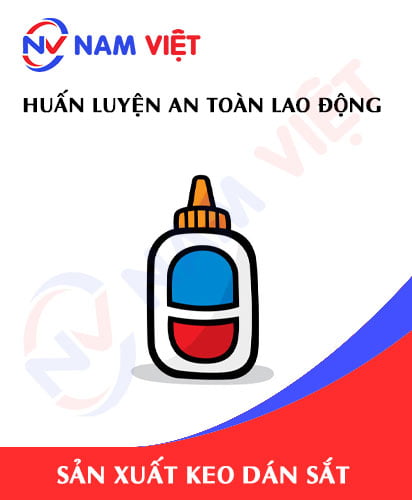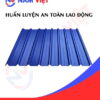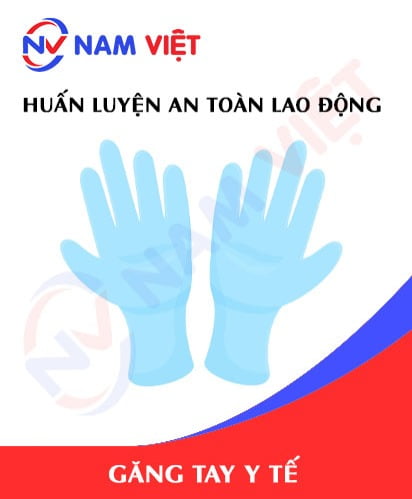Occupational Safety Training for Iron Glue Manufacturing
99,000 ₫
Note: The above price is calculated for one person and may vary depending on the number of participants in the course and market fluctuations. For more accurate pricing support, please refer to the price list or contact our consulting staff directly.
Occupational safety is an important issue in iron glue manufacturing factories and needs to be addressed promptly to ensure the health and safety of workers, as well as to enhance the reputation of businesses. The Occupational Safety Training course is one of the effective solutions to raise awareness among workers on how to prevent work accidents when participating in iron glue manufacturing.
Table of Contents
Toggle1. Overview of Iron Glue
a. What is Iron Glue?
- Iron glue is a type of glue used to bond metal surfaces together, creating a strong and durable connection. It is commonly used in mechanical engineering, construction, household appliance manufacturing, automotive, machinery, electronics, and many other industries.
- Iron glue can be produced from various chemical compounds depending on its intended use and the properties of the metal surfaces being bonded.
- Currently, the iron glue manufacturing industry in Vietnam is developing with many businesses. This industry plays an important role in producing products for construction, mechanical engineering, electronics, and other sectors.
- However, like many other industries, iron glue manufacturing in Vietnam faces challenges, including inadequately trained labor, limited raw material supply, intense price competition, and issues related to occupational safety and environmental protection.

b. Machinery for Iron Glue Production
Types of machinery used in iron glue production include:
- Mixing machine: used to mix glue with other components to create iron glue.
- Pressing machine: used to press iron glue onto metal products.
- Coating machine: used to coat glue onto metal surfaces.
- Quality testing machine: used to test the quality of iron glue according to standards.

c. Notable Iron Glue Manufacturers
Some notable iron glue manufacturers in Vietnam include:
- Sika Vietnam Group
- Minh Hung Industrial Glue Co., Ltd.
- Viet Nhat Glue Co., Ltd.
- Thanh Nhat Production, Trade Co., Ltd.
- Dai Nam Production, Trade & Service Co., Ltd.
These are major, reputable companies with high-quality products that are well-regarded in the Vietnamese market.
d. Specific Jobs in Iron Glue Production Plants
Group 1
- Executive Director, Deputy Executive Director, Department Heads in iron glue production plants.
Group 2
- Safety officers: manage safety within the plant, design safety procedures, monitor and ensure staff compliance with safe working protocols.
Group 3
- Material preparation: includes glue, iron, additives, packaging, etc.
- Glue mixing: ingredients are blended to form the iron glue mixture.
- Bottle preparation: bottles are checked and cleaned to ensure they are not broken or contaminated during filling.
- Glue filling: once preparation is complete, bottles are placed in the filling machine and glue is dispensed through a conduit. The quantity filled per bottle depends on machine settings.
- Product inspection: after filling, products are checked to ensure correct volume and no spillage or contamination on the bottle surface.
- Packing: products are packaged appropriately before shipping.
Group 4
- Office work, support, sales, marketing.
- Production management, quality management, human resources, materials management, accounting and finance management.
- Research and development of new products, design of product packaging and labeling.

2. Overview of Labor Safety Training for Iron Glue Production
In this article, we focus on Group 3 because Group 3 directly participates in production and faces the highest occupational safety risks. Refer to other groups here.
a. What is Group 3 Labor Safety Training?
- Group 3 labor safety training consists of sessions that equip workers with awareness on preventing occupational accidents.
- The training helps workers recognize and avoid hazards, reducing the risk of workplace accidents during work.
REGISTER FOR LABOR SAFETY TRAINING SERVICE
b. Training Duration
Initial Safety Training
- Total training duration is at least 24 hours, including examination time.
- 8 hours theoretical on policies and occupational safety laws
- 8 hours theoretical on basic occupational safety and hygiene knowledge
- 4 hours theoretical on specialized training content
- 2 hours practical on specialized content
- 2 hours final theory examination
The training center schedules sessions according to workers’ availability. Typically, there are 6 sessions over 3 days if the company can arrange continuous training time.
Periodic Safety Training
- Before the labor safety card expires, workers must undergo periodic labor safety training if they want a card renewal. The periodic training duration must be at least 50% of the initial training duration.
Explanation: the total duration of periodic labor safety training is at least 12 hours, including examination. Upon completion and passing the test, workers will receive a renewed labor safety card.
c. Training Content
| No. | TRAINING CONTENT | DURATION (HOURS) | |||
| Total | Including | ||||
| Theory | Practice | Test | |||
| I | Policies and occupational safety laws | 8 | 8 | 0 | 0 |
| 1 | Overview of legal documents regarding occupational safety and hygiene. | 6 | 6 | ||
| 2 | System of standards and technical regulations on occupational safety and hygiene. | 1 | 1 | ||
| 3 | Specific regulations from state management agencies on safety, hygiene when constructing, expanding, or renovating facilities, using and maintaining machinery and materials with strict safety and hygiene requirements. | 1 | 1 | ||
| II | Basic knowledge of occupational safety and hygiene | 8 | 8 | 0 | 0 |
| 1 | Basic knowledge of hazards and harmful factors at the workplace. | 4 | 4 | ||
| 2 | Methods to improve working conditions. | 1 | 1 | ||
| 3 | Safety culture in production and business. | 1 | 1 | ||
| 4 | Rights and responsibilities of employers and employees; policies on occupational safety and hygiene; roles of safety network personnel. | 1 | 1 | ||
| 5 | Safety regulations, signs, instructions, using protective equipment, first aid skills, and occupational disease prevention. | 1 | 1 | ||
| III | Specialized training content | 6 | 4 | 2 | 0 |
| Comprehensive knowledge of machinery, devices, hazardous substances; risk assessment and management; safe working procedures for machines, devices, and materials with strict safety requirements. | 6 | 4 | 2 | ||
| IV | Final safety training assessment | 2 | 2 | 0 | 0 |
| Total | 24 | 22 | 2 | ||
See more training content for all 6 groups
d. Labor Safety Card
After completing the training and passing the test, workers will receive a labor safety card (commonly called Group 3 labor safety certificate).
The Group 3 card clearly shows the worker’s name, date of birth, specific job and working environment, training duration, official stamp, and signature confirming training completion.
According to Clause 2 of Article 24 of Decree 44/2016/ND-CP, there are two cases:
- If the worker has an employment contract with the employer, the employer must sign, stamp, and validate the card for the Group 3 trainee after completing training and passing the test.
- If the worker is freelance or temporary without a contract, the training unit must sign, stamp, and validate the card after completing training and passing the test.

3. Identifying Hazards in Iron Glue Production
Potential hazards in iron glue production include:
- Iron glue contains chemicals such as fillers, thickeners, gloss enhancers, strength agents, surfactants, solvents, etc. Long-term exposure can cause skin irritation, headaches, dizziness, respiratory and digestive issues.
- Volatile solvents in glue can pose fire and explosion risks if improperly handled or stored.
- Using machinery and equipment can be hazardous due to pressure risks. Heavy and bulky materials increase the chance of accidents during transport and handling.
- Production processes may generate high noise levels, affecting worker health if ear protection is not used.
4. Common Occupational Accidents in Iron Glue Production
Common occupational accidents include:
- Fire and explosion: Glue is produced by mixing chemicals, creating risks if mishandled or exposed to sunlight or high heat.
- Chemical poisoning: Chemicals such as toluene, xylene, formaldehyde can be toxic if improperly used or if protective equipment is insufficient.
- Cuts and crushing: High-tech machinery like cutters, presses, and mixers can cause severe hand injuries if used incorrectly or safety protocols are not followed.
- Electric shock: Some machinery uses high voltage; improper use or insufficient protection may cause electric shock.
- High temperature: Production may involve high heat and pressure, posing hazards without proper handling or heat dissipation systems.
- Hazardous gases: Production may emit carbon dioxide, formaldehyde vapors, and dust, which are dangerous if not properly controlled.

5. Safety Measures When Participating in Iron Glue Production
Safety measures when participating in iron glue production include:
- Employees participating in iron glue production must be fully equipped with protective gear such as helmets, safety goggles, gloves, waterproof jackets, and anti-slip shoes.
- All employees involved in iron glue production must be trained in occupational safety and the proper use of protective equipment. In addition, they should be trained in the correct use of production equipment and handling incidents.
- The iron glue production factory must be regularly cleaned to ensure no waste or dust is dispersed into the air. Employees should also be trained on proper handling of chemicals and maintaining workplace hygiene.
- Working conditions must be adequate, especially regarding temperature, humidity, and lighting. When working with machinery, sufficient lighting is necessary for employees to see details clearly and operate correctly.
- Machinery must be regularly inspected and maintained to ensure proper and safe operation. Worn or damaged parts must be replaced promptly.
- Materials must be properly classified and stored to prevent accidents and ensure the safety of employees involved in production.
- Employees should minimize exposure to hazardous substances during iron glue production, especially when handling chemicals.
- Periodically conduct occupational environment monitoring in factories, collect and analyze harmful factors for workers, and adjust to reduce hazards to prevent occupational diseases.
6. Benefits of Occupational Safety Training in Iron Glue Production
An Toan Nam Viet provides your enterprise with the following benefits after completing occupational safety training courses according to Decree 44/2016/ND-CP on Occupational Health and Safety for companies and enterprises:
- Workers can identify potential occupational hazards and take preventive measures to avoid accidents.
- Your enterprise can establish risk prevention measures in production, operation, and maintenance processes.
- Reduce costs associated with potential safety risks in labor.
- Uninterrupted production increases labor productivity and product quality.
- Ensure compliance with labor safety laws, avoiding legal risks.
- Create credibility and professionalism in all aspects, thereby enhancing your enterprise’s brand.
Nam Viet’s training courses are solutions to prevent and counter external hazards that could cause injury or, in severe cases, death.
REGISTER FOR OCCUPATIONAL SAFETY TRAINING SERVICES
7. Customer Feedback After Completing Iron Glue Production Safety Training
An Toan Nam Viet has many years of experience in accompanying enterprises in Vietnam in general and southern provinces in particular. This responsibility is extremely valuable to Nam Viet, which is why the Occupational Safety Training program has been increasingly professional. The motivation for Nam Viet’s growth comes from positive feedback and suggestions from enterprises. Below are testimonials from our partners.
Bac Nam E&C Construction Investment Joint Stock Company
“My first experience using An Toan Nam Viet services surprised me with the 24/7 enthusiastic support from the consulting team. The class organization was very quick and convenient for our company. Thank you very much for Nam Viet’s service!”
Hoa Dat Construction and Trading Joint Stock Company
“Nam Viet’s services greatly helped us simplify occupational safety and complete safety documentation for work processes. The consulting team responded promptly to our inquiries. Five stars for Nam Viet.”
See more customer interviews after using the services from An Toan Nam Viet
8. Occupational Safety Training Capability of An Toan Nam Viet
An Toan Nam Viet is a reputable and quality center for occupational safety training in Vietnam today, with courses continuously held at production workshops, factories, or construction sites nationwide (63 provinces).
REGISTER FOR OCCUPATIONAL SAFETY TRAINING SERVICES
Occupational Safety Training License
- An Toan Nam Viet has been inspected and certified by the Department of Safety under the Ministry of Labor – Invalids and Social Affairs and granted a certificate for occupational safety and hygiene training, reinforcing our capacity in occupational safety training.

Training Materials and Lectures
- Before being included in occupational safety training courses, all training materials are reviewed to ensure accurate knowledge and effective application.
- The teaching methods of instructors are standardized according to An Toan Nam Viet‘s teaching standards, developed by occupational safety experts to maximize knowledge absorption for trainees.
Facilities
- Controlling factors in classrooms that affect training improves teaching efficiency and knowledge absorption.
- Our training facilities always provide spacious classrooms meeting standards for area, lighting, training equipment, etc.
9. Nationwide Reputable Occupational Safety Training Center
At An Toan Nam Viet, we prioritize the professional dedication to occupational safety training. For us, imparting knowledge to workers to protect themselves is a contribution to nation-building.
To ensure effective training, we meticulously prepare all aspects, from tools, equipment, and teaching aids to curriculum, materials, sound, and lighting.
Our occupational safety instructors are experts with many years of experience, including research in hazard identification across industries and preventive methods.
Instructors’ lessons are practical, presented vividly for easy understanding, helping workers stay comfortable while learning. All content adheres closely to Decree 44/2016/ND-CP.
Consequently, workers learn various hazard prevention measures and self-protection techniques, applying them appropriately in real work situations.
Our training center proudly provides professional and reputable occupational safety training with the following advantages:
- Competitive training costs while maintaining quality.
- Flexible training schedules aligned with company production.
- Quick certification procedures following legal regulations.
- Experienced instructors with many years in the field.
- Classrooms are controlled to optimize teaching efficiency and knowledge retention.
- Lessons are tailored to workplace safety practices in enterprises.
- An Toan Nam Viet works diligently and professionally to support clients accurately and quickly.

10. Additional References for Iron Glue Production Occupational Safety Training
- Iron Glue Production Safety Materials (Glue)
- Occupational Safety Training Materials Collection
- Occupational Safety Training Test Collection
- Iron Glue Production Safety Quiz
- Iron Glue Production Safety Training Slides
1 review for Occupational Safety Training for Iron Glue Manufacturing
No comments yet















namchinh.haiphong341
Bài giảng rất sinh động!